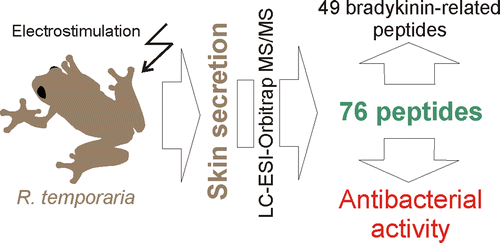Frog-in-bucket-of-milk folklore leads to potential new antibiotics

Following up on an ancient Russian way of keeping milk from going sour—by putting a frog in the bucket of milk—scientists have identified a wealth of new antibiotic substances in the skin of the Russian Brown frog. The study appears in ACS' Journal of Proteome Research.
A. T. Lebedev and colleagues explain that amphibians secrete antimicrobial substances called peptides through their skin. These compounds make up the majority of their skin secretions and act as a first line of defense against bacteria and other microorganisms that thrive in the wet places frogs, toads, salamanders and other amphibians live. A previous study identified on the skin of the Russian Brown frog 21 substances with antibiotic and other potential medical activity. Lebedev's team set out to find more of these potential medical treasures.
They used a sensitive laboratory technique to expand the list of such substances on the frogs' skin, identifying 76 additional substances of this kind. They describe lab tests in which some of the substances performed as well against Salmonella and Staphylococcus bacteria as some prescription antibiotic medicines. "These peptides could be potentially useful for the prevention of both pathogenic and antibiotic resistant bacterial strains while their action may also explain the traditional experience of rural populations," the scientists concluded.
More information: "Composition and Antimicrobial Activity of the Skin Peptidome of Russian Brown Frog Rana temporaria", J. Proteome Res., 2012, 11 (12), pp 6213–6222. DOI: 10.1021/pr300890m
Abstract
A nano-HPLC-ESI-OrbiTrap study involving HCD and ETD spectra has been carried out to clarify the composition of the skin peptidome of brown Russian frogs Rana temporaria. This approach allowed determinantion of 76 individual peptides, increasing 3-fold the identified portion of the peptidome in comparison to that obtained earlier with FTICR MS. A search for the new bradykinin related peptides (BRPs) was carried out by reconstructing mass chromatograms based on the ion current of characteristic b- and y-ions. Several peptides were reported in the secretion of R. temporaria for the first time. The overall antibacterial activity of the skin secretion in general and of one individual peptide (Brevinin 1Tb) was determined using PMEU Spectrion (Portable Microbe Enrichment Unit) technology. The inhibitory effects of these peptides on Staphylococcus aureus and Salmonella enterica Serovar typhimutium were equal in scale to that reported for some antibiotics.
Journal information: Journal of Proteome Research
Provided by American Chemical Society



















